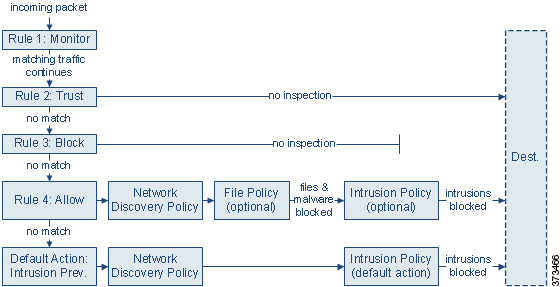Access control traffic handling with intrusion and file policies
The following diagram shows the flow of traffic in an inline intrusion prevention and malware defense deployment, as governed by an access control policy that contains four different types of access control rules and a default action.

In the scenario above, the first three access control rules in the policy—Monitor, Trust, and Block—cannot inspect matching traffic. Monitor rules track and log but do not inspect network traffic, so the system continues to match traffic against additional rules to determine whether to permit or deny it. (However, see an important exception and caveat at Access Control Rule Monitor Action.) Trust and Block rules handle matching traffic without further inspection of any kind, while traffic that does not match continues to the next access control rule.
The fourth and final rule in the policy, an Allow rule, invokes various other policies to inspect and handle matching traffic, in the following order:
-
Discovery: Network Discovery Policy—First, the network discovery policy inspects traffic for discovery data. Discovery is passive analysis and does not affect the flow of traffic. Although you do not explicitly enable discovery, you can enhance or disable it. However, allowing traffic does not automatically guarantee discovery data collection. The system performs discovery only for connections involving IP addresses that are explicitly monitored by your network discovery policy.
-
malware defense and File Control: File Policy—After traffic is inspected by discovery, the system can inspect it for prohibited files and malware. malware defense detects and optionally blocks malware in many types of files, including PDFs, Microsoft Office documents, and others. If your organization wants to block not only the transmission of malware files, but all files of a specific type (regardless of whether the files contain malware), file control allows you to monitor network traffic for transmissions of specific file types, then either block or allow the file.
-
Intrusion Prevention: Intrusion Policy—After file inspection, the system can inspect traffic for intrusions and exploits. An intrusion policy examines decoded packets for attacks based on patterns, and can block or alter malicious traffic. Intrusion policies are paired with variable sets, which allow you to use named values to accurately reflect your network environment.
-
Destination—Traffic that passes all the checks described above passes to its destination.
An Interactive Block rule (not shown in the diagram) has the same inspection options as an Allow rule. This is so you can inspect traffic for malicious content when a user bypasses a blocked website by clicking through a warning page.
Traffic that does not match any access control rules in the policy with an action other than Monitor is handled by the default action. In this scenario, the default action is an Intrusion Prevention action, which allows traffic to its final destination as long as it is passed by the intrusion policy you specify. In a different deployment, you might have a default action that trusts or blocks all traffic without further inspection. Note that the system can inspect traffic allowed by the default action for discovery data and intrusions, but not prohibited files or malware. You cannot associate a file policy with the access control default action.
Note | Sometimes, when a connection is analyzed by an access control policy, the system must process the first few packets in that connection, allowing them to pass, before it can decide which access control rule (if any) will handle the traffic. However, so these packets do not reach their destination uninspected, you can specify an intrusion policy (in the advanced settings for the access control policy) to inspect these packets and generate intrusion events. |